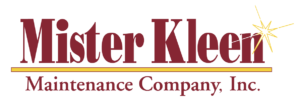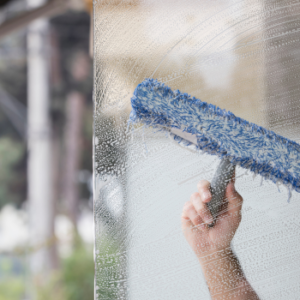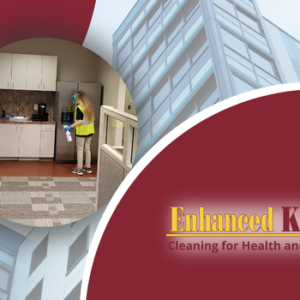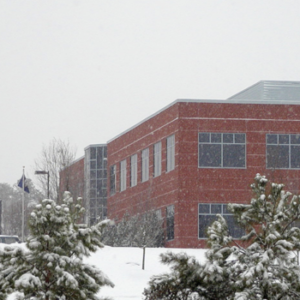Sustainable cleaning – sometimes referred to as “green cleaning” – reduces the exposure to potentially hazardous products, equipment, or processes that can adversely affect our health within the indoor work environment.
Three (3) key areas to pay attention to inside your facility to help achieve a healthier indoor environment include: chemicals, materials and equipment, and sustainable procedures.
Chemicals
Ironically, the same chemicals we’ve spent so much time reducing our exposure to outdoors has now made its way into our work environment – where we spend the majority of our time. Many cleaning products release Volatile Organic Compounds (VOC’s), which is a major component in the formation of smog.
There are many traditional household cleaners that contain an unnecessary amount of VOC’s that are toxic, such as Clorox, Pine sol, and Lysol. Repeated exposure to harsh chemicals with a high level of VOC’s over a long period of time can lead to major health issues. In some cases, people can also be bothered by low levels of exposure.
It is imperative that you limit the use of harsh cleaners, solvent based cleaners or cleaners that emit a strong fragrance. Instead, choose low-emitting products that are third-party certified and labeled by a reputable organization, such as Green Seal. Also, be wary of manufacturer claims of “no VOC”, “natural” or “alternative.” Read the labels and keep a look-out for the following clues:
Materials & Equipment
The right powered cleaning equipment can help reduce the exposure of building occupants and maintenance personnel to potentially hazardous particulate contaminants that affect air quality and our indoor health.
For instance, using a vacuum cleaner that has strong suction, rotating brushes and a HEPA filter ensures that dust and dirt won’t get blown back out in the exhaust. Using a vacuum cleaner with a HEPA filter also effectively helps get rid of other toxins, like brominated fire-retardant chemicals (PBDEs) as well as allergens like pollen, pet dander, and dust mites.
Using the right cleaning materials can also help ensure the indoor environments we work in is as healthy as can be. Microfiber mops and microfiber cleaning cloths, for instance, capture more dust and debris than traditional fibers and don’t require any cleaning solutions.
The USGBC lists credit requirements of proper cleaning equipment to be used inside LEED certified facilities. The following page provides a snippet of their requirements, which should be followed in all facilities to improve our indoor health.
Sustainable Procedures
In conjunction with ensuring proper cleaning chemicals and equipment are being used, the right sustainable procedures need to be followed.
Green Seal, a non-profit environmental development certification organization provides sustainable cleaning standards and criteria to protect human health and the environment. Their GS-42 for commercial and industrial cleaning services provides a standard of not only tools and products to be used for cleaning, but also procedures for how cleaning is to be done. To become GS-42 certified, cleaning companies must be following these requirements at a minimum:
- Proper storing and use of chemicals
- Cleaning procedures to reduce solid waste (e.g. reusable cleaning cloths or microfibers to be used in lieu of paper products, and making sure these microfibers are laundered prior to reuse)
- Proper use of vacuums and maintenance
- Proper floor care (hard surface floors and carpets) and entryway cleaning
- Trash collecting and recycling
- Cleaning of dining areas and break rooms
Our indoor work environment needs to be as healthy as can be. Reducing the amount of harmful pollutants to improve overall indoor air quality is an ongoing challenge for facilities and maintenance teams.
Using the right cleaning chemicals, equipment, materials and procedures that are environmentally safe and green certified help facilities provide a healthier working environment. Healthier employees are far more focused and productive to achieve mission critical objectives, not to mention a big savings on your bottom line.
If you have questions regarding the cleanliness of your facility and the impact this is having on workplace performance, then we encourage you to reach out to us below. We’d be more than happy to provide you a free no-hassle assessment, which takes a look at:
- Chemicals, equipment and materials being used inside your facility
- Sustainable cleaning procedures
- Overall cleanliness of your facility to ensure harmful pollutants are not impacting workplace performance
Mister Kleen is a leading provider of contract cleaning services to Commercial and High Security facilities since 1976. Our primary service area is the DC Metro region. We also provide a variety of interior and exterior specialty services.
Tags: chemicals, Green Cleaning, Green Seal, GS-42, HEPA filter, LEED, Materials & Equipment, microfiber cleaning cloths, Microfiber mops, sustainable cleaning, Sustainable Procedures, USGBC, VOC's, Volatile Organic Compounds
Categories: Blog

